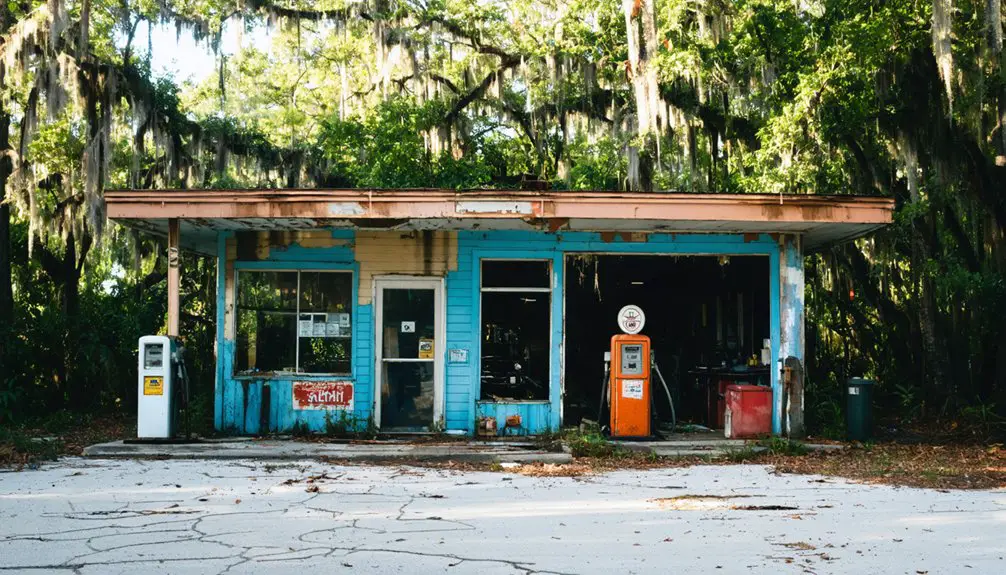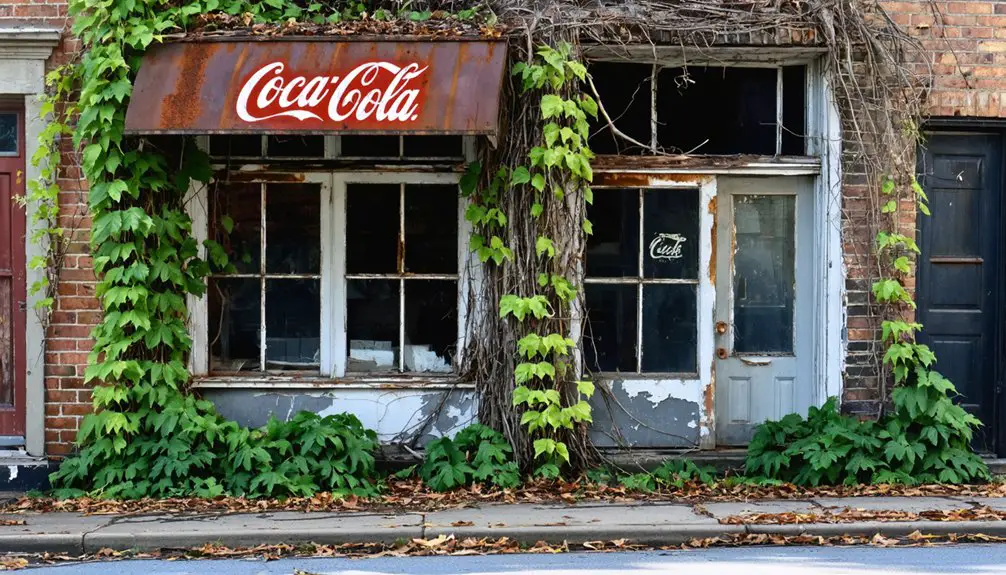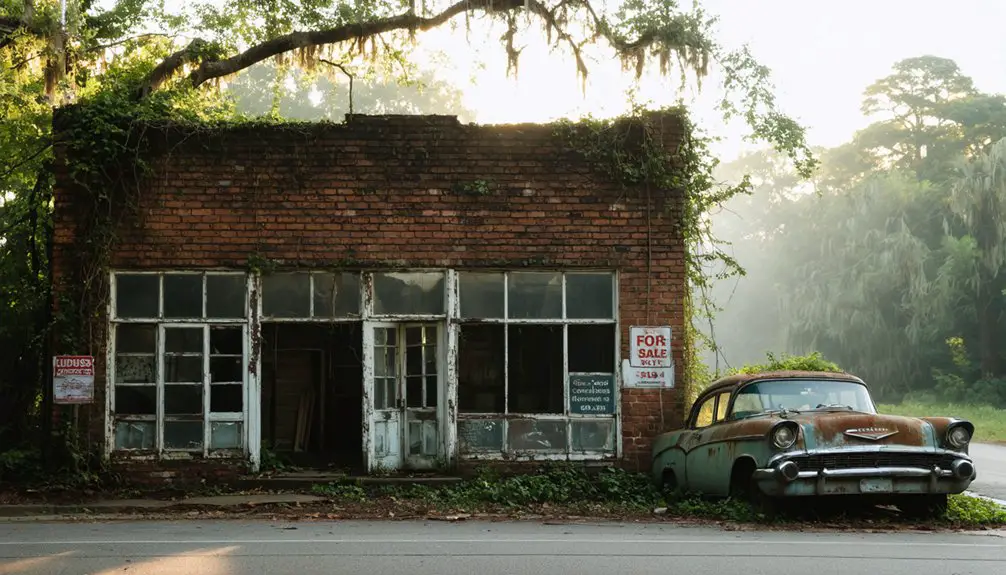You’ll discover the remnants of Centralia in Hernando County, Florida, where J.C. Turner’s lumber empire once produced 100,000 board feet daily between 1910-1922. This thriving company town housed up to 1,500 workers, complete with a general store, restaurant, church, and movie house. Today, nature has reclaimed the abandoned settlement, though scattered artifacts from the early 1900s remain beneath the thick forest canopy. The site’s rich history holds many more untold stories.
Key Takeaways
- Centralia was a thriving lumber town established in 1910 by J.C. Turner Lumber Company in Hernando County, Florida.
- The town supported 1,500-2,000 residents with amenities including a general store, restaurant, church, movie house, and housing options.
- The lumber mill produced 100,000 board feet daily and employed 1,200 workers until the depletion of cypress forests in 1917.
- Following the sawmill’s closure, Centralia experienced rapid abandonment as residents left, leading to the closure of all businesses.
- Nature has reclaimed the ghost town, with native vegetation overtaking former buildings and railroad infrastructure.
The Birth of a Lumber Empire
When John Charles Turner graduated from Michigan’s Hillsdale College near Jackson, he couldn’t have predicted his future role in establishing one of Florida’s most significant lumber operations.
After cutting his teeth in sales with Chicago-based Joseph Rathbone, Turner’s destiny shifted during a pivotal moment in East St. Louis, where he witnessed the untapped potential of cypress shingles.
A chance encounter with cypress shingles in East St. Louis sparked Turner’s transformation from salesman to lumber industry pioneer.
You’ll find Turner’s entrepreneurial spirit came alive in 1910 when he established the J.C. Turner Lumber Company in Centralia, Florida.
His vision transformed 15,000 acres of pristine coastal Hernando County into a lumber industry powerhouse, harvesting valuable Red Tidewater Cypress, cedar, and pine.
The company’s strategic position near vast cypress timber stands, combined with Turner’s business acumen, laid the foundation for what would become a thriving lumber empire. The mill’s impressive daily cut capacity of 100,000 board feet made it unrivaled in the region.
Following the industry standard of the era, workers at the mill earned ten cents per hour while residing in company-provided housing.
Life in a Bustling Mill Town
As a mill worker in early 1900s Centralia, you’d start your day at the Central Cypress Lumber Co., joining up to 1,500 other employees to produce 100,000 board feet of lumber daily.
You’d find comfort in the town’s alcohol-free environment, where soda pop flowed freely at social gatherings and community events centered around the local church and movie house.
After your shift, you could visit the well-stocked general store, grab a meal at the Hungry None restaurant, or attend services at the community church where both Catholic and Protestant congregations gathered. The nearby Dixie Highway provided a vital transportation link for residents traveling between Brooksville and Aripeka. The town flourished until the valuable cypress trees were depleted, leading to its eventual abandonment.
Daily Worker Routines
Life in bustling Centralia revolved around the demanding rhythms of the Turner Lumber Company‘s massive sawmill operation. You’d start your day early, joining the stream of 1,200 workers heading to their assigned posts.
Daily routines varied by role – if you were a millwright, you’d tend to the complex machinery, while logging crews tackled the physically demanding task of felling and transporting enormous cypress logs. The crews relied heavily on the railroad lines to move timber efficiently.
Worker challenges included long shifts in challenging conditions, but you’d find support through the town’s amenities. After clocking out with the timekeeper, you could visit the well-stocked general store, seek care from the resident doctor, or return to your boarding house or family home.
Without alcohol available, you’d join your fellow workers in choosing soda pop to quench your thirst after a demanding day’s work.
Community Social Activities
Beyond the daily grind of mill work, Centralia’s residents found warmth and connection through the town’s varied social spaces and community institutions.
You’d find social traditions centered around family-friendly activities, with community gatherings at the local church serving both Catholic and Protestant congregations. Without saloons in town, folks gathered at the Hungry None Restaurant and Greek bakery, sharing conversation over soda pop instead of alcohol. The town flourished until the sawmill shut down, forcing residents to seek opportunities elsewhere.
- The movie house provided entertainment and escape from mill life.
- School events and church services brought families together regularly.
- The well-stocked general store served as an informal meeting spot.
- Railroad arrivals became social occasions as new supplies came in.
- The boarding house and hotel hosted social interactions between workers and visitors.
Railway Networks and Transportation
When Centralia emerged as a bustling lumber town in the early 1900s, its complex railway infrastructure formed the backbone of its economic success.
You’ll find evidence of three distinct rail systems that once served this ghost town: extensive tramways that snaked through cypress swamps, an 18-mile narrow gauge line connecting to Brooksville, and the Tampa Northern Railroad that linked Centralia to regional markets.
The rail transport network wasn’t just about moving lumber – it was essential for workers commuting from nearby communities like Wiscon and Tooke Lake.
The sawmill operation utilized tramways to transport harvested timber from the surrounding wetlands to processing facilities.
The Seaboard Airline Railroad later acquired the Tampa Northern Railroad tracks.
While the town thrived, reaching 2,000 residents, its dependence on rail transportation proved fatal once the cypress forests were depleted.
Today, you can explore remnants of these railways within the Chassahowitzka Wildlife Management Area, where nature slowly reclaims the abandoned corridors.
The Turner Lumber Company Legacy
You’ll find that Turner Lumber Company’s Tidewater Cypress Mill stood as one of Florida’s largest lumber operations, processing an impressive 100,000 board feet of lumber daily through its electrically-powered sawmill system.
The company’s workforce of up to 1,500 residents made Centralia larger than nearby Brooksville, with the mill’s advanced steam-powered equipment and 18 miles of tram lines supporting this massive operation.
Your understanding of Turner’s economic impact deepens when you consider their strategic establishment of a Hudson River wholesale yard in New York, which expanded their market reach well beyond Florida’s borders.
Mill Operations and Scale
As one of Florida’s most ambitious timber operations of the early 1900s, the Turner Lumber Company’s Tidewater Cypress Mill revolutionized logging in Hernando County through its impressive infrastructure and cutting-edge technology.
You’ll find the scale of lumber production was remarkable, with double-banded saws capable of processing 100,000 board feet daily. The mill’s advanced logging technology included steam-powered skidders and four massive boilers that powered the entire operation.
- 18 miles of narrow-gauge tram lines connected remote swamp logging sites to the mill
- Steam-powered machinery enabled continuous cutting operations at peak efficiency
- 160-acre drying yard stored lumber for up to four years before processing
- On-site electric power generation drove the massive double-banded saws
- Mill pond operations facilitated efficient log handling before cutting
Workforce and Economic Impact
The Turner Lumber Company‘s economic influence reached far beyond its Centralia mill, employing hundreds of workers during peak operations from 1910-1922.
You’ll find that labor relations centered around physically demanding jobs, from skilled skidder operators to sawmill workers, all living in company-established housing typical of lumber towns. Workers stayed refreshed with soda pop only, as alcohol was strictly prohibited in the town.
The mill’s impressive output of 100,000 board feet per day supported robust economic sustainability through national distribution networks.
Their strategic Hudson River wholesale yard connected Centralia’s premium cypress lumber to lucrative New York markets.
While workers endured challenging conditions in swampy, insect-laden environments, the operation generated significant economic activity throughout Hernando County.
This prosperity lasted until 1922, when the depletion of 15,000 acres of old-growth cypress forced the mill’s closure, ending Centralia’s economic golden age.
Community Infrastructure and Daily Life

Despite its remote location in rural Florida, Centralia developed into a well-equipped company town with infrastructure serving 1,500-2,000 residents during its peak.
The Turner Lumber Company established diverse community services and residential variety to sustain their workforce, creating a self-sufficient settlement that rivaled neighboring towns in size and amenities. The town’s prosperity was built around the massive cypress sawmill that employed most residents.
- You’d find a mix of housing options, from family homes to a boarding house and hotel
- A narrow gauge railway connected residential areas to the sawmill and nearby worker communities
- The town’s movie house, church, and school formed the social and educational core
- Daily necessities were met through local establishments like the drugstore and restaurant
- Community gathering spots fostered connections among residents despite the town’s industrial focus
The Great Decline and Abandonment
Centralia’s bustling community life came to an abrupt end when its economic foundation crumbled in 1917. The complete depletion of old-growth cypress forests forced the sawmill to shut down, triggering devastating economic repercussions throughout the community.
You would’ve witnessed a rapid exodus as 1,200 residents fled the dying town. The post office, general store, schoolhouse, and local businesses couldn’t survive the population drain.
The once-vital railroad infrastructure and timber processing facilities fell into disrepair, while the ecological consequences of clear-cutting left the surrounding land barren and degraded.
Nature’s Reclamation of Centralia

While nature gradually reclaimed the abandoned settlement over decades, you can now find a thriving forest ecosystem where Centralia’s buildings once stood.
Through natural succession, native hardwoods and grasses have overtaken the remnants of human occupation, with wildlife reoccupation transforming the ghost town into a vibrant woodland habitat within the Chassahowitzka Wildlife Management Area.
- Dense forest canopy shrouds scattered purple-tinted glass and ceramic fragments from the early 1900s
- Former railroad right-of-way slowly disappears beneath thick underbrush and leaf litter
- Local fauna, from small mammals to birds, now inhabit the regenerating landscape
- Natural water drainage patterns have reemerged, stabilizing once-eroded terrain
- Rich soil development continues as organic matter accumulates over old foundations
Preserving Florida’s Logging Heritage
As Florida’s lumber industry shaped the state’s development from 1880 to 1930, its legacy lives on through carefully preserved artifacts, historical records, and protected landscapes.
You’ll find this logging preservation most evident in the conversion of former logging sites into state parks like Fakahatchee Strand Preserve, where nature and industrial heritage coexist.
The Florida Forestry Association, established in 1921, continues to champion heritage conservation while promoting sustainable forest management.
You can trace the industry’s evolution through preserved company towns, which tell the story of workers shifting from farming to industrial labor.
The creation of Florida National Forest, combining Ocala and Choctawhatchee forests, stands as a reflection of early 20th-century conservation efforts that balanced resource use with preservation, ensuring future generations can experience this essential piece of Florida’s history.
Frequently Asked Questions
Were There Any Major Accidents or Disasters at the Centralia Sawmill?
You won’t find records of any major industrial accidents at the sawmill operations. While standard logging hazards existed, historical archives and research show no documented disasters or significant casualties.
What Happened to the Original Residents After Leaving Centralia?
Like seeds scattered in the wind, original residents dispersed to nearby Pennsylvania towns. You’ll find they faced economic hardship, lost community bonds, and adapted to new lives following relocation impacts.
Are There Any Ghost Stories or Legends Associated With Centralia?
You won’t find documented ghost sightings or urban legends tied to Centralia’s ruins. Unlike many Florida ghost towns, it’s known more for its natural reclamation than any supernatural stories or haunted history.
Can Visitors Legally Explore the Centralia Site Today?
You can legally explore within Chassahowitzka Wildlife Management Area’s regulations, though there aren’t specific exploration permits required. Just follow standard visitor regulations and respect the natural protected environment when exploring.
What Native American History Existed in the Area Before Centralia?
Like ancient footprints in time, you’ll find the Seminoles and Timucua were the main Native tribes in this land, establishing villages and leaving shell mounds that mark their historical significance.
References
- https://floridatrailblazer.com/2018/01/25/centralia-ghost-town-in-hernando-county/
- http://www.gribblenation.org/2018/06/florida-friday-where-hell-is-centraila.html
- http://www.fivay.org/centralia.html
- https://www.youtube.com/watch?v=fAu5kj5Q5uo
- https://centraliarailroad.com/history-of-centralia/
- http://historichernandopreservationsociety269.bravesites.com/files/documents/Cypress-Logging-at-Centralia-8-22-15-edit-9-19-17-m.pdf
- https://naturecoaster.com/lacoochee-lumber/
- https://www.youtube.com/watch?v=F-1EU-SqySs
- https://dirtmedic.wordpress.com/2013/08/27/centralia-ghost-town-florida/comment-page-1/
- https://www.nps.gov/parkhistory/online_books/steamtown/shs2d.htm



